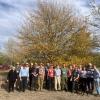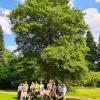Editor's Picks
Plant Focus
Roderick Cameron
Published May 2018 in International Oaks No. 29: 181–193
Introduction
In the October 1943 issue of American Forests, Arthur Bevan wrote about a remarkable discovery:
Nine degrees of latitude north of the Equator—the same latitude that runs through the Panama Canal—and here we were walking through what is perhaps the largest single stand of oak timber in the world. If that surprises you, you are in good company. The foresters in our party were amazed. It simply couldn't be true … Magnificent giants 125 feet or more tall, heavily buttressed at their base to a height of ten or twelve feet, and with diameters above the buttresses of from seven to eight feet. Here were trees to excite the imagination, a whole forest of them … To add to our awe, clouds swirled through the trees giving the whole setting a ghostly appearance … one almost expected to see witches on broom sticks and large hats flying out of the timber … We immediately dubbed the forest "The Ancestral Home of the Gremlins."
Bevan and his colleagues were members of a project field party that was in Costa Rica in connection with the construction of the Inter-American Highway that would run through all of Central America. They had been requested by army engineers building the highway to examine a stand of large timber along the right-of-way. “The giant oaks were our reward,” wrote Bevan. The foresters were not able to identify the species of oak, but samples were sent to the Chicago Museum of Natural History, where Dr. Paul Standley declared them to be Quercus copeyensis, or Copey oak, a species named by C.H. Muller the previous year. In his article, Bevan expresses concern that a considerable portion of the stand would be logged for the construction of the highway and other uses. However, plans were in place to create a national park to preserve the remainder of the trees. “Perhaps,” he concludes, “some day tourists driving over this jungle road will experience the same thrill on entering the forest of oaks that we—a group of exploring foresters—did.”
In October 2017 I was fortunate enough to be one of those tourists.
Further reading
Anywhere: Costa Rica. National Parks of Costa Rica. Accessed December 28, 2017. https://www.anywhere.com/costa-rica/attractions/national-park
Bevan, A. Giant Oaks of Costa Rica. American Forests 49 (1943): 486-487, 503.
Blaser, J., and M. Camacho. Estructura, composición y aspectos silviculturales de un bosque de robles (Quercus spp.) del piso montano en Costa Rica. Centro Agronómico Tropical de Investigación y Enseñanza, CATIE, Programa Manejo Integrado De Recursos Naturales, Proyecto Silvicultura De Bosques Naturales, 1991.
Burger, W. 1977. Flora costaricensis. Fieldiana: Botanical Series. Vol. 40. Chicago: Field Museum of Natural History, 1977.
Bouricius, B. Costa Rica: Astounding high altitude "Grandfather Oak". Post on the Eastern Native Tree Society Bulletin Board System. Accessed December 28, 2017. http://www.ents-bbs.org/viewtopic.php?p=28399
Cordero J., and D.H. Boshier. Árboles De Centroamérica: Un Manual Para Extensionistas. Oxford Forestry Institute/CATIE, 2003.
IUCN. Oaks of the Americas Species List. International Oak Society website. Accessed January 28, 2017. http://www.internationaloaksociety.org/content/oak-red-listing-project-update
Jiménez, Q., A. Estrada, and M. Arroyo. Manual dendrológico de Costa Rica. Cartago, Costa Rica: Instituto Tecnológico de Costa Rica, 1996.
Little, E.L., Jr. Copey oak, Quercus copeyensis in Costa Rica. Caribbean Forester Vol. 9 (1948): 345-353.
Le Hardÿ de Beaulieu, A., and T. Lamant. Guide illustré des Chênes. 2nd ed. Geer, Belgium: Edilens, 2010.
MonumentalTrees.com. Q. bumelioides 'Grandfather Oak' in Parque Nacional Cerro de la Muerte in Cartago. Accessed December 28,2017. https://www.monumentaltrees.com/en/cri/centralvalley/cartago/9751_parquenationalcerrodelamuerte/
Muller, C.H. The Central American Species of Quercus. Washington: United States Dept. of Agriculture, 1942.
Oak Name Checklist. Accessed December 28, 2017. http://www.oaknames.org/
Smithsonian Institution, Smithsonian Tropical Research Institute. Accessed December 28, 2017. http://www.stri.si.edu/
Standley, P.C. Flora of Costa Rica, Part 1. Chicago: Field Museum of Natural History. Vol. 18 (1937).
Trelease, W. The American Oaks. National Academy of Science Memoirs. Vol . 20 (1924).
Valencia Avalos, S. Diversidad del Género Quercus (Fagaceae) en México. Boletín de la Sociedad Botánica de México 75 (2004): 33-53.
World Checklist of Selected Plant Families: Royal Botanic Gardens, Kew. Accessed January 28, 2017. http://apps.kew.org/















